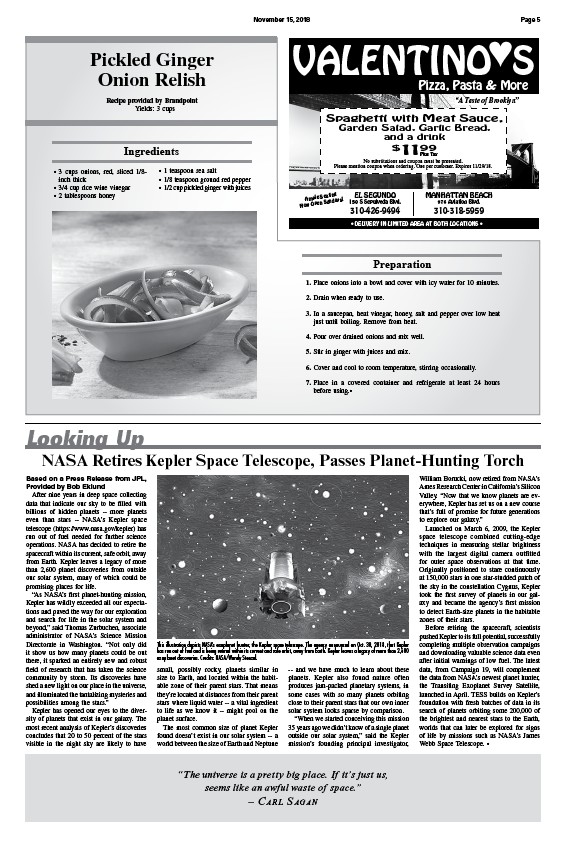
November 15, 2018 Page 5
Pickled Ginger
Onion Relish
Recipe provided by Brandpoint
Yields: 3 cups
Ingredients
• 3 cups onions, red, sliced 1/8-
inch thick
• 3/4 cup rice wine vinegar
• 2 tablespoons honey
• 1 teaspoon sea salt
• 1/8 teaspoon ground red pepper
• 1/2 cup pickled ginger with juices
Pizza, Pasta & More VALENTINO S
“A Taste of Brooklyn”
Spaghetti with Meat Sauce,
Garden Salad, Garlic Bread,
and a drink
$1199
Plus Tax
No substitutions and coupon must be presented.
Please mention coupon when ordering. One per customer. Expires 11/29/18.
EL SEGUNDO
150 S Sepulveda Blvd.
310-426-9494
MANHATTAN BEACH
• DELIVERY IN LIMITED AREA AT BOTH LOCATIONS •
Preparation
Ample Seating
Now Open Sundays!
976 Aviation Blvd.
310-318-5959
1. Place onions into a bowl and cover with icy water for 10 minutes.
2. Drain when ready to use.
3. In a saucepan, heat vinegar, honey, salt and pepper over low heat
just until boiling. Remove from heat.
4. Pour over drained onions and mix well.
5. Stir in ginger with juices and mix.
6. Cover and cool to room temperature, stirring occasionally.
7. Place in a covered container and refrigerate at least 24 hours
before using.•
Looking Up
NASA Retires Kepler Space Telescope, Passes Planet-Hunting Torch
Based on a Press Release from JPL,
Provided by Bob Eklund
After nine years in deep space collecting
data that indicate our sky to be filled with
billions of hidden planets -- more planets
even than stars -- NASA’s Kepler space
telescope (https://www.nasa.gov/kepler) has
run out of fuel needed for further science
operations. NASA has decided to retire the
spacecraft within its current, safe orbit, away
from Earth. Kepler leaves a legacy of more
than 2,600 planet discoveries from outside
our solar system, many of which could be
promising places for life.
“As NASA’s first planet-hunting mission,
Kepler has wildly exceeded all our expectations
and paved the way for our exploration
and search for life in the solar system and
beyond,” said Thomas Zurbuchen, associate
administrator of NASA’s Science Mission
Directorate in Washington. “Not only did
it show us how many planets could be out
there, it sparked an entirely new and robust
field of research that has taken the science
community by storm. Its discoveries have
shed a new light on our place in the universe,
and illuminated the tantalizing mysteries and
possibilities among the stars.”
Kepler has opened our eyes to the diversity
of planets that exist in our galaxy. The
most recent analysis of Kepler’s discoveries
concludes that 20 to 50 percent of the stars
visible in the night sky are likely to have
This illustration depicts NASA’s exoplanet hunter, the Kepler space telescope. The agency announced on Oct. 30, 2018, that Kepler
has run out of fuel and is being retired within its current and safe orbit, away from Earth. Kepler leaves a legacy of more than 2,600
exoplanet discoveries. Credits: NASA/Wendy Stenzel.
small, possibly rocky, planets similar in
size to Earth, and located within the habitable
zone of their parent stars. That means
they’re located at distances from their parent
stars where liquid water -- a vital ingredient
to life as we know it -- might pool on the
planet surface.
The most common size of planet Kepler
found doesn’t exist in our solar system -- a
world between the size of Earth and Neptune
-- and we have much to learn about these
planets. Kepler also found nature often
produces jam-packed planetary systems, in
some cases with so many planets orbiting
close to their parent stars that our own inner
solar system looks sparse by comparison.
“When we started conceiving this mission
35 years ago we didn’t know of a single planet
outside our solar system,” said the Kepler
mission’s founding principal investigator,
William Borucki, now retired from NASA’s
Ames Research Center in California’s Silicon
Valley. “Now that we know planets are everywhere,
Kepler has set us on a new course
that’s full of promise for future generations
to explore our galaxy.”
Launched on March 6, 2009, the Kepler
space telescope combined cutting-edge
techniques in measuring stellar brightness
with the largest digital camera outfitted
for outer space observations at that time.
Originally positioned to stare continuously
at 150,000 stars in one star-studded patch of
the sky in the constellation Cygnus, Kepler
took the first survey of planets in our galaxy
and became the agency’s first mission
to detect Earth-size planets in the habitable
zones of their stars.
Before retiring the spacecraft, scientists
pushed Kepler to its full potential, successfully
completing multiple observation campaigns
and downloading valuable science data even
after initial warnings of low fuel. The latest
data, from Campaign 19, will complement
the data from NASA’s newest planet hunter,
the Transiting Exoplanet Survey Satellite,
launched in April. TESS builds on Kepler’s
foundation with fresh batches of data in its
search of planets orbiting some 200,000 of
the brightest and nearest stars to the Earth,
worlds that can later be explored for signs
of life by missions such as NASA’s James
Webb Space Telescope. •
“The universe is a pretty big place. If it’s just us,
seems like an awful waste of space.”
– Carl Sagan